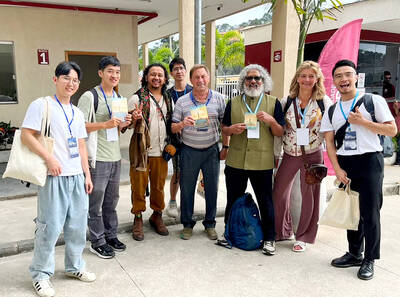To record his next hit, El Micha, one of Cuba’s rising stars of reggaeton music, which blends reggae, Latin and electronic rhythms, just has to knock on his neighbor’s door.
A microphone plugged into an old computer in an apartment in Havana’s working-class suburb of Reparto Electrico serves as the studio where some of Cuba’s most successful reggaeton songs are recorded.
“Reggaeton is unstoppable because it is recorded at home. It is totally independent,” says Michael “El Micha” Sierra, 27, a former basketball player whose bottom row of gold teeth flash when he gives one of his frequent broad smiles.
With little official support or air time on state-controlled radio, the songs Cuban reggaeton artists record in makeshift studios lined with egg cartons for sound insulation are mostly transmitted though homemade CDs and on computer flash memory sticks.
That is how the tropical fever of reggaeton is sweeping communist-ruled Cuba, captivating its youth and enraging a cultural establishment alarmed by the vulgarity of some of its lyrics, which include phrases like “Coge mi tubo” (“Grab my pipe”) and “Metela” (“Stick it in”).
“Cubans know about music and if they picked reggaeton they have to be respected. The people are the ones who decide,” said Sierra.
Reggaeton, a cocktail of reggae, Latin and electronic rhythms, first became popular in Puerto Rico in the mid-1990s and has spread rapidly through Latin America. In Cuba, it is played on crowded buses, shakes neighborhood windows with its throbbing bass and packs discos night after night.
Its vibrations even seem to be shaking Cuba’s cultural establishment, decades after the island shook the entertainment music world with its native-born mambo and cha cha cha.
Like hip-hop, its relative, reggaeton chronicles real life in the streets. But its popularity stems from a catchy, sensual rhythm that is perfectly suited for dance-crazy Cubans.
OFFICIAL ALARM OVER ‘NEOLIBERAL’ MUSIC
“Teachers and family cannot be naive regarding this matter,” warned state-controlled TV as it showed six-year-olds doing covers of Puerto Rican reggaeton megastar Daddy Yankee.
That was the latest sign of official alarm over what the authorities see as a vulgarization of Cuban culture.
The official daily Juventud Rebelde called reggaeton a reflection of “neoliberal thinking” and Culture Minister Abel Prieto said it should be “pushed away.”
“In the cultural world there is concern about the excessive popularity of reggaeton,” Julian Gonzalez, president of the National Council for Visual Arts, said.
But at a disco in Guanabo, a beach resort just east of Havana where El Micha played on a recent Sunday, 28-year-old kindergarten teacher Selene showed little sign of concern, however, shaking her hips frenetically to the music.
“It is true, reggaeton can sometimes have vulgar lyrics. But I like it and dance it,” she said. “Come on. Do they want young people to dance danzon?”
Some Cuban officials have suggested promoting more traditional Cuban dance rhythms like danzon, son and casino to counter the reggaeton offensive.
“Declaring war on reggaeton would be a mistake. These are not times for that kind of response,” said Gonzalez.
He may be right, says Puerto Rican researcher Raquel Z. Rivera, co-editor of Reggaeton, a book recently published by Duke University Press. An attempt to ban it in Puerto Rico only made it more popular.
“Cuban authorities are wary for the same reason as authorities in other countries — reggaeton tends to be hypersexual and to glorify consumerism and fashion,” she said.
PREJUDICES AND PIRACY
Cuban reggaeton musicians say prejudices keep them off the recording labels and radio airwaves. Their music cannot be found in stores. Fans simply burn their own CDs.
“In Cuba, reggaeton moves thanks to piracy,” said El Micha.
A beginner typically records at a makeshift studio for US$2 an hour, burns as many CDs as he can afford to and spreads them around. Some became famous giving free CDs to taxi drivers.
A few have achieved local success like Gente de Zona, Baby Lores or Kola Loka, and some even dream of breaking into the US market including Elvis Manuel, a 19-year-old reggaeton star who disappeared last year while trying to cross the Florida Straits to the US.
But most just fly under the radar only to emerge during weekends for concerts at state-owned discos.
“Reggaeton is treading a fine line between official and unofficial/independent worlds,” said Geoff Baker, a lecturer at the University of London’s Royal Holloway College who has researched the topic in Cuba.
Cuban reggaeton has a distinctive rhythm from its Puerto Rican roots, local musicians say. It is also less violent in its lyrics than the imported version.
“My lyrics talk about what young people live without getting into politics, because I don’t really care about that. Reggaeton is music for people’s pleasure,” said El Micha as he got ready to go on stage.

This month the government ordered a one-year block of Xiaohongshu (小紅書) or Rednote, a Chinese social media platform with more than 3 million users in Taiwan. The government pointed to widespread fraud activity on the platform, along with cybersecurity failures. Officials said that they had reached out to the company and asked it to change. However, they received no response. The pro-China parties, the Chinese Nationalist Party (KMT) and Taiwan People’s Party (TPP), immediately swung into action, denouncing the ban as an attack on free speech. This “free speech” claim was then echoed by the People’s Republic of China (PRC),

Exceptions to the rule are sometimes revealing. For a brief few years, there was an emerging ideological split between the Democratic Progressive Party (DPP) and Chinese Nationalist Party (KMT) that appeared to be pushing the DPP in a direction that would be considered more liberal, and the KMT more conservative. In the previous column, “The KMT-DPP’s bureaucrat-led developmental state” (Dec. 11, page 12), we examined how Taiwan’s democratic system developed, and how both the two main parties largely accepted a similar consensus on how Taiwan should be run domestically and did not split along the left-right lines more familiar in

Specialty sandwiches loaded with the contents of an entire charcuterie board, overflowing with sauces, creams and all manner of creative add-ons, is perhaps one of the biggest global food trends of this year. From London to New York, lines form down the block for mortadella, burrata, pistachio and more stuffed between slices of fresh sourdough, rye or focaccia. To try the trend in Taipei, Munchies Mafia is for sure the spot — could this be the best sandwich in town? Carlos from Spain and Sergio from Mexico opened this spot just seven months ago. The two met working in the

Many people in Taiwan first learned about universal basic income (UBI) — the idea that the government should provide regular, no-strings-attached payments to each citizen — in 2019. While seeking the Democratic nomination for the 2020 US presidential election, Andrew Yang, a politician of Taiwanese descent, said that, if elected, he’d institute a UBI of US$1,000 per month to “get the economic boot off of people’s throats, allowing them to lift their heads up, breathe, and get excited for the future.” His campaign petered out, but the concept of UBI hasn’t gone away. Throughout the industrialized world, there are fears that